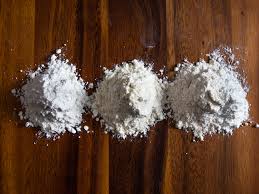





Published on Feb 13, 2025
The objective: Investigate whether there is a difference in rise between bleached and unbleached flour. This experiment also serves as a fun cooking lesson for kids and afterwards, you can actually bake the dough into yummy bread.
Flour is a powder made from grinding cereal grains, other seeds, or roots. It is very universal and can be made into many different edible foods such as cookies, bread, crackers, piz z a, pasta, and more. Some flour is bleached for commercial reasons and some isn't.
Are there any differences between them in how fast the dough rises?
In how puffy the dough gets?
The texture?
Technically, all flours are bleached, but it's the process by which it happens that sets these two types of flour apart. Bleached flour is treated with chemical agents to speed up aging, while unbleached flour is bleached naturally as it ages. This affects not only the color and grain of each type of flour but the end result of baked goods.
Bleached flour uses bleaching agents (commonly benzoyl peroxide and chlorine gas, among others) to speed up the flour's aging process. This results in a whiter, finer-grain flour with a softer texture. Some people with sensitive palate can notice a difference in taste with bleached flour. The bleaching process softens the flour, the effects of which are reflected in finished baked goods. Foods made with bleached flour tend to have a softer texture, more volume, and a brighter color than those made with unbleached flour. Bleached flour is best for making cookies, pie crusts, quick breads, muffins, and pancakes.
Unbleached flour is flour that has aged naturally after being milled. It has an off-white color, which continues to dull as it ages, and a more dense grain than bleached flour. Just because this type of flour hasn't been bleached doesn't necessarily mean it hasn't been treated with other chemicals. All brands are different, so it's important to read the label to know what you're buying. Unbleached flour also takes longer than bleached flour to produce, and because of this, it's usually more expensive. Having a denser texture, unbleached flour provides more structure in baked goods, which makes it an ideal base for things like yeast breads, cream puffs, eclairs, and pastries.

1. Unbleached All-Purpose Flour
2. Bleached All-Purpose Flour
3. Sugar
4. Salt
5. Yeast
6. Two large mixing bowls
7. Measuring spoon and cups
8. Water
9. Saran/plastic wrap
10. Timer
11. Pen/paper for notes
1. Activate the yeast one tablespoon of yeast by putting it in with the two tablespoons of sugar.
2. Wait 15 minutes.
3. Add two cups of unbleached flour in one mixing bowl and two cups of bleached flour in the other.
4 . Dig a “pit” into the center of the flour.
5. Add ½ tablespoon salt to each bowl.
6. Add ½ of the yeast + sugar combination in each bowl.
7. Add 3/4 cup of lukewarm water into each bowl.
8. Knead the dough until it is well combined- not sticky but not dry. If it is too sticky, then add some flour, if it is too dry, then add some water (a little at a time!)
9. When you are done, cover both bowls with plastic wrapa and leave both kinds of flour to rise.
10. Watch which dough rises first and which one rose higher.
http://en.wikipedia.org/wiki/Dough
http://whatscookingamerica.net/Bread/FlourTypes.htm